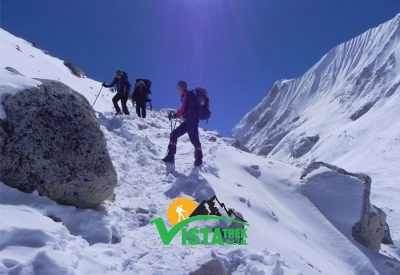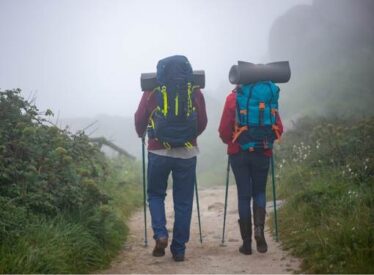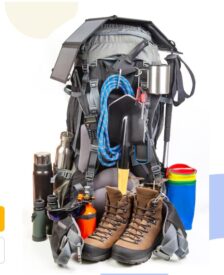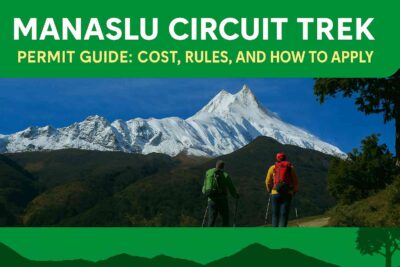Planning to trek the Manaslu Circuit? That’s an epic adventure—but without Manaslu circuit trek preparation, it can easily go from dream trip to nightmare. This is one of Nepal’s most scenic and challenging routes, circling the majestic Mt. Manaslu and crossing the 5,160-meter Larkya La Pass. To fully enjoy the journey, you’ll need to understand the Manaslu trek difficulty level, train your body for high-altitude endurance, bring the right gear, and secure the necessary permits.
In this blog, we’ll break it all down in a friendly, practical way. You’ll find expert insights, real-world advice, and a clear fitness plan tailored for high-altitude trekking.
Let’s go into what it really takes to prepare for the Manaslu Circuit Trek.
The Manaslu Circuit Trek is challenging but achievable with the right mindset and preparation. It’s not just about fitness—it’s about stamina, mental toughness, and understanding the terrain.

This trek isn’t just a scenic stroll—it’s a real test of endurance and determination. That said, people of all ages and fitness levels have completed it with the right preparation.
Tip: Plan your itinerary with at least two acclimatization days and follow the “hike high, sleep low” principle.
The best way to enjoy the Manaslu Circuit is to train your body and mind in advance. Starting your preparation early gives your body time to adapt and your confidence time to grow.
The goal isn’t to become a marathoner. It’s to comfortably move for hours every day, carrying a pack, and climbing elevation without injury. Tracking your fitness progress in a notebook or app helps you stay motivated and gives you a clear picture of your Manaslu Circuit Trek preparation journey.
Tip: Practice walking two consecutive days to mimic trek fatigue. This builds not only strength but also recovery ability.
Recommended Packages: Manaslu Expedition
Endurance is everything when it comes to high-altitude treks like Manaslu. The trail may not be vertical climbing, but it’s long and tiring, especially at thin oxygen levels.
Don’t neglect your cardio. Regular jogging, swimming, or cycling can boost your capacity, making it easier to breathe at altitude.
Tip: Try to use a heart rate monitor to track your progress and avoid overexertion.
Creating a structured fitness plan helps you build strength and stamina without burnout. A balanced mix of cardio, strength, and flexibility will condition your body for long days on the trail.
The goal isn’t to become a marathoner—it’s to move comfortably for hours every day, carrying a pack, without injury.
Tip: Track your fitness journey in a notebook or app to stay motivated and see your progress.
Recommended Packages: Manaslu & Tsum Valley Trek 21 Days
When it comes to Manaslu Circuit Trek preparation, understanding the challenges of high-altitude trekking is crucial. Unlike hiking at sea level, the reduced oxygen at higher elevations forces your body to work harder with every step. It’s not just about strong legs—it’s also about efficient lungs, smart pacing, and smart hydration.

Walking uphill may feel twice as hard at high altitudes. By preparing in advance, your body will adapt to the demands of the trail.
Tip: Avoid pushing yourself too hard during the first few days of the trek. Let your body adjust naturally.
Recommended Packages: Manaslu Annapurna Double Circuit Trek 22 Days
Your fitness plan for high-altitude treks like Manaslu should simulate the stress your body will face: reduced oxygen, long days, and loaded backpacks.
A strong core and stable joints will prevent injury. Avoid overtraining—allow recovery days and listen to your body.
Tip: Do your final long hike about a week before departure to test your gear and readiness.
Having the right gear is as important as your physical fitness. Bad boots or insufficient layers can lead to blisters, cold nights, and a miserable trek.

Tip: Organize gear in packing cubes or dry sacks for easier access and waterproofing.
To legally trek the Manaslu Circuit, you’ll need multiple permits, which must be processed via a registered trekking agency in Nepal. The Nepalese government strictly controls access to this restricted area, issuing only limited restricted area permits weekly during peak seasons (September-November). Also, solo trekking is not allowed in this region. Here are the permits and their fee for accessing the trek to Manaslu Circuit.

Price: $100 for the first 7 days (Sept–Nov), $75 (Dec–Aug)
Price: $30 per person
Price: $30 per person
You must travel with a licensed guide and at least one other trekker, as enforced by the Nepal Tourism Board.
Tip: Carry both printed and digital copies of your permits. Checkpoints will verify them often.
Contact Vista Treks now and enjoy a safe, amazing adventure!
The Manaslu Circuit Trek is one of Nepal’s most rewarding adventures, offering breathtaking views, rich culture, and challenging terrain. You can confidently take on this epic trail with correct Manaslu Circuit trek preparation.
Start early, stay consistent, and respect the mountain. Whether you’re hiking for personal growth or for the thrill of the Himalayas, Manaslu is an unforgettable journey when approached with care.
If you’re ready to experience the raw, untouched beauty of the Manaslu region, get training, get packing, and we’ll see you on the trail. Book your trek with Vista Treks now!
Since 2023, the government mandates at least 2 trekkers with a licensed guide. Guides know hidden trails, manage bookings, and handle emergencies. Vista Treks provides experienced guides with wilderness first-aid training.
You should book at least 6 months in advance. Last-minute bookings may face permit shortages.
Yes! Medical clearance, extra acclimatization days, and lightweight gear are recommended. We provide senior-friendly packing lists.
You should bring essential medicines like Diamox, ibuprofen, blister patches, and oral rehydration salts. We also provide a comprehensive first aid kit.
There will be Ncell coverage up to Lho village (Day 4) and no signal beyond Samdo (Day 8). We provide satellite phones.
Guides carry GPS locators, and helicopter rescue is possible within 2-4 hours (weather permitting). Emergency funds are covered upfront.
Rare Himalayan black bears (guides carry deterrents). More common: Dogs in villages (keep distance).
We are the only company with a dedicated altitude medic on staff, customizable itineraries, and a post-trek recovery lounge in Kathmandu.
The trek typically takes 13–17 days, depending on your pace and whether you include acclimatization days.